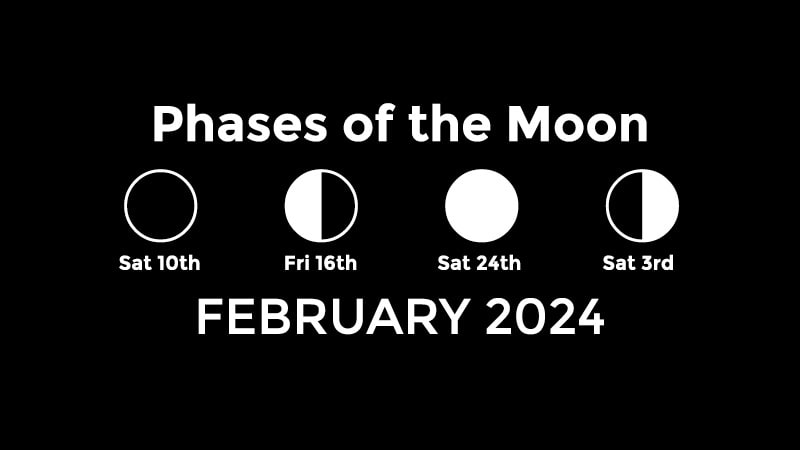Find out what to go out and look at this month
Planets:
In the celestial tapestry of February’s early morning sky. Mercury, Venus, and Mars gracefully traverse the vast constellation of Sagittarius (The Archer) before dawn. As the month progresses, their celestial journey leads them into the constellation Capricornus (The Sea-Goat). Venus and Mars, will grace the night sky throughout February and even be viewable in the same telescope eyepiece on the 23rd of February. However, Mercury, the elusive messenger, will retreat into the Sun’s radiant glow, bidding farewell to the stargazers two-thirds into the month.
In the evening night sky, Jupiter commands attention as it asserts its presence between the cosmic realms of Cetus (The Sea-Monster), and Aries (The Ram), throughout the entire month. Meanwhile, Saturn, the majestic ringed giant, graces the constellations of Aquarius (The Water Bearer), until it succumbs to the Sun’s brilliance halfway through February.
Uranus, the first of the ice giants, positions itself gracefully between the constellations of Aries, and Taurus (The Bull). Neptune, the azure wanderer, navigates the starry seas between the constellations of Pisces (The Fish), and Cetus. As the month draws to a close, Neptune, too, vanishes into the Sun’s radiant farewell.
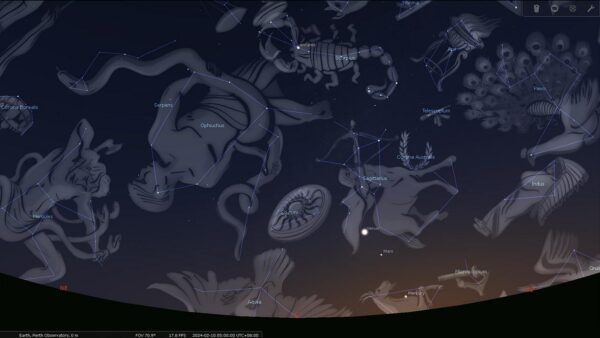
|
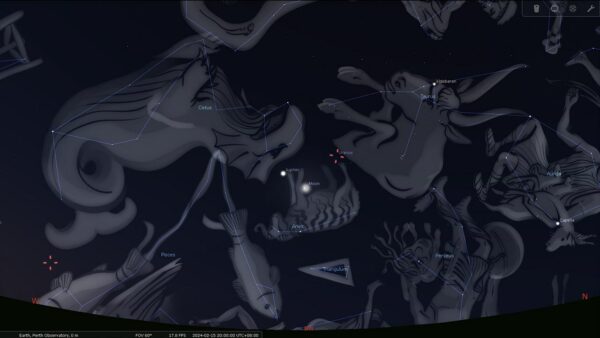
|
| Planet | When It Rises Or Sets |
|---|---|
| Mercury | From the middle of February, it’ll rise at 04:12 am (AWST), and by the end of the month, it’ll be lost to the Sun’s glare |
| Venus | At the start of February, it’ll rise at 03:15 pm (AWST), and by the end of the month, it’ll set at 04:07 am (AWST) |
| Mars | At the start of February, it’ll rise at 03:59 am (AWST), and by the end of the month, it’ll set at 3:52 pm (AWST) |
| Jupiter | At the start of February, it’ll set at 11:21 pm (AWST), and by the end of the month, it’ll set at 098:42 pm (AWST) |
| Saturn | At the start of February, it’ll set at 08:35 pm (AWST), and by the end of the month, it’ll be in the Sun’s glare |
| Uranus | At the start of February, it’ll set at 11:53 pm (AWST), and by the end of the month, it’ll set at 10:06 pm (AWST) |
| Neptune | At the start of February, it’ll set at 09:26 pm (AWST), and by the end of the month, it’ll be lost to the Sun’s glare |
Conjunctions And Occultations:
Conjunctions involve object(s) in the Solar System and/or more distant objects, such as a star. It’s an apparent phenomenon in which multiple objects which aren’t close together appear close in the sky and it’s caused by the observer’s perspective.
In an occultation, an object passes across the line of sight between an observer and another object. A solar eclipse is an occultation of the Sun by the Moon.
- 02/02/24 – Conjunction of The Moon, and Spica (Where to look)
- 05/02/24 – Conjunction of The Moon, and Antares (Where to look)
- 07/02/24 – Alignment of Mercury, Venus, and Mars (Where to look)
- 08/02/24 – Conjunction of The Moon, Mercury, Venus, and Mars (Where to look)
- 09/02/24 – Conjunction of The Moon, and Mercury (Where to look)
- 15/02/24 – Conjunction of The Moon, Jupiter, and Uranus (Where to look)
- 16/02/24 – Conjunction of The Moon, and Pleiades (Where to look)
- 18/02/24 – Conjunction of The Moon, Mars, and Elnath (Where to look)
- 21/02/24 – Conjunction of The Moon, Castor, and Pollux (Where to look)
- 23/02/24 – Conjunction of Venus, and Mars (Where to look)
- 24/02/24 – Conjunction of The Moon, Algieba, and Regulus (Where to look)
- 28/02/24 – Conjunction of The Moon, and Spica (Where to look)
Things to Look at This Month:
Flame Nebula:
The Flame Nebula (NGC 2024) is an emission nebula in the constellation of Orion (The Hunter). It is about 900 to 1,500 light-years away and it’s 12 light-years across. The nebula can be located near the bright star Alnitak, the easternmost star in the Belt of Orion. Alnitak shines energetic ultraviolet light into the flame, and this knocks electrons away from the great clouds of hydrogen gas that reside there.
Much of the glow results when the electrons and ionized hydrogen recombine. Additional dark gas and dust lie in front of the bright part of the nebula, and this is what causes the dark system that appears in the centre of the glowing gas. The Flame Nebula is part of the Orion molecular cloud complex, a star-forming region that includes the famous Horsehead Nebula.
At the centre of the Flame Nebula, is an open cluster of newly formed stars, 86% of which have circumstellar disks. X-ray observations by the Chandra X-ray Observatory show several hundred young stars, out of an estimated population of 800 stars. X-ray and infrared images indicate that the youngest stars are concentrated near the centre of the cluster.
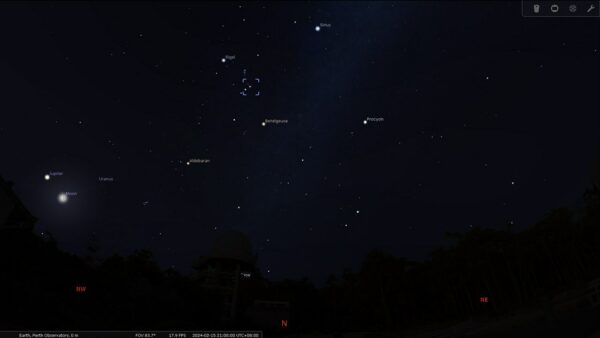
|
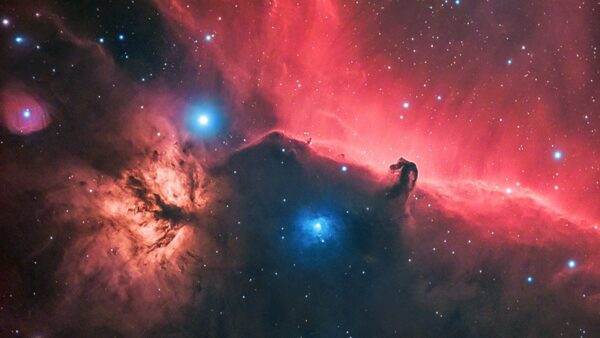
|
Messier 46:
Messier 46 is an unusual open star cluster in that it appears to have a planetary nebula (NGC2438) embedded in it. The cluster is about 40 light-years across and located some 5,500 light-years away from Earth. There are an estimated 500 stars in the cluster, and most are around 300 million years old — very young for stars. While the planetary nebula appears to lie within M46, it is most likely unrelated to the cluster as it doesn’t share the cluster’s radial velocity. The star of this planetary nebula is a white dwarf with a surface temperature of about 74,700°C which makes it one of the hottest stars known to us.
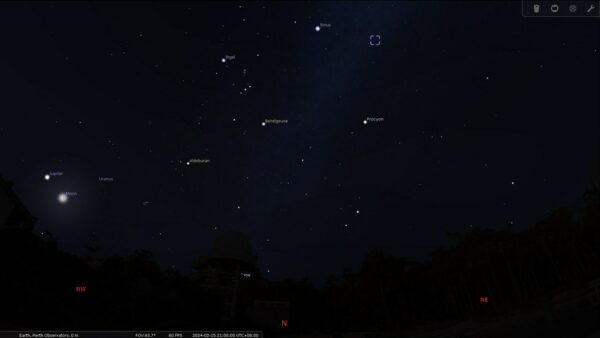
|
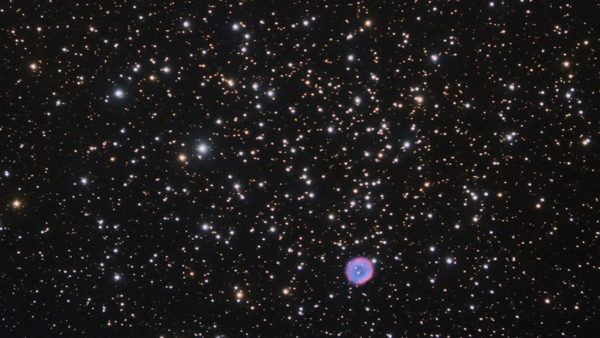
|
Eta Carinae And The Carina Nebula:
Variable brightness and Colour, Eta Carinae is one of the most remarkable stars in the heavens. When we say “Eta Carinae” we refer to the star itself which for Perth is a circumpolar star (We see the star all year round) and not the nebula. Eta Carinae is 100 times the Sun’s mass and 4 million times brighter; this brightness has been unstable with the star being recorded over the past 300 years between magnitude -0.8 which is as bright as Canopus and +7.9. It’s a star that is sometimes in the news as it’s expected to become a supernova within the next 1 million years and will be a spectacular sight when it occurs, being visible by day and possibly bright enough to read by at night.
Eta Carinae is very likely a binary star with a smaller partner orbiting in a highly elliptical orbit of 5.5 years. The Carina Nebula (NGC 3372), which surrounds Eta Carinae, is a large, bright star-formation region that has produced several very massive stars including Eta Carinae. At around 260 light-years the Carina Nebula is around 7 times the size of the Great Orion Nebula, but due to its greater distance, it only spans twice the width. There are many O-type stars, young (~2 million years), hot and bright that energise the entire Carina nebulae.
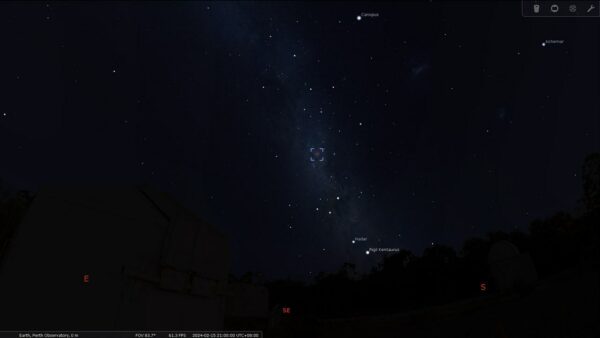
|
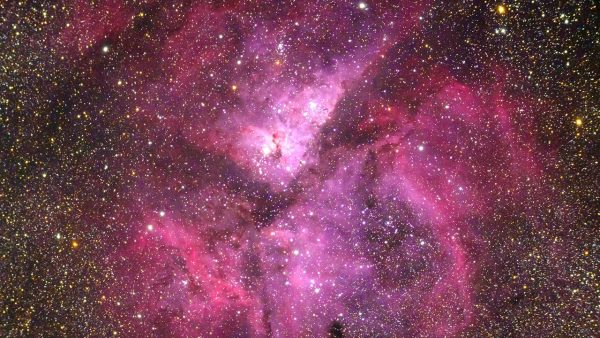
|
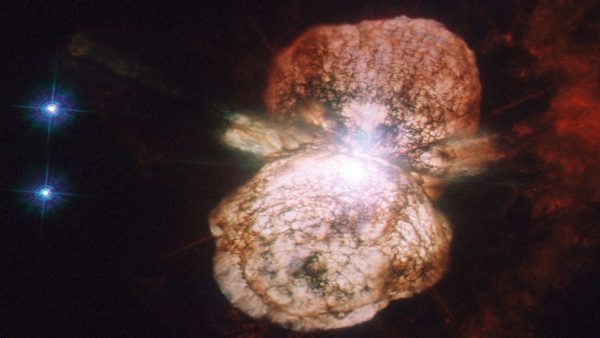
|
Pearl Cluster:
The Pearl Cluster (NGC 3766) is a medium-sized open cluster in the constellation of Centaurus. Discovered by Nicholas Louis de Lacaille in 1752 where he spent two years at Table Bay, South Africa, the cluster is 5500 light-years away from Earth and 20 light-years across. The cluster is estimated to be around 15 million years old, forming from the large molecular cloud around the Carina region.
The area of the Pearl Cluster consists of around 140 stars and its super large and hot young stars have dispersed the nebulosity that surrounded the cluster. The cluster is not visible from 28° North (e.g., All of the UK and Europe north of the Mediterranean, most of the USA) and It’s circumpolar from Perth.
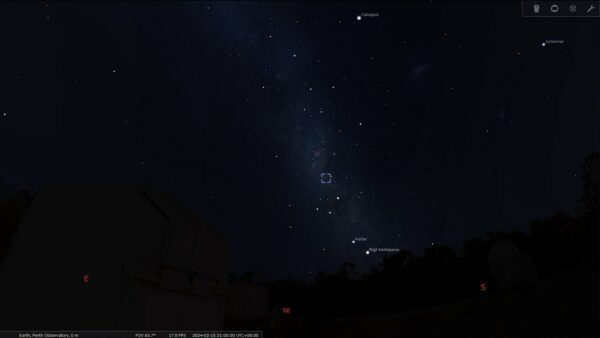
|
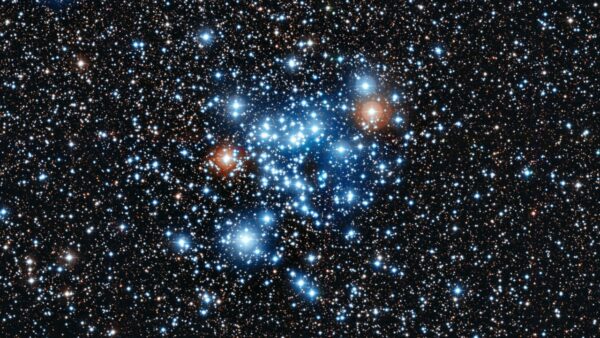
|
Phases Of The Moon:
